GAM 2012 Blog
|
April 7 By Ricardo Cardoso Reis |
Back to the GAM Blog |  |
|
With the solar maximum of 2013 approaching fast, you’ll be hearing a lot more news about “the greatest solar explosion since…” (well, probably since the last one!). But what are these explosions, and how can they affect us, here on the surface of the Earth? |
||
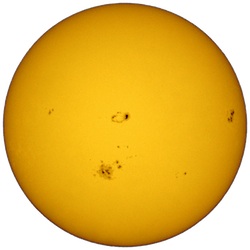 The Sun has an activity cycle, which lasts (on average) about 11 years, and it roughly relates to our daily activity.
The Sun has an activity cycle, which lasts (on average) about 11 years, and it roughly relates to our daily activity.
Our activity starts when we wake up, peaks in the middle of the day, and ends when we go to sleep. The Sun also “wakes up” in the beginning of its cycle, peaks, and then “goes to sleep” at the end of each cycle.
There is a visual indicator of our star’s activity in its surface – Sunspots.
Sunspots are known for many centuries, with descriptions of dark spots in the Sun reaching us from the b.C. eras. But the first definitive sunspot observation had to wait until 1610, after the invention of the telescope, when either Galileo Galilei or Thomas Harriot projected the Sun through their telescopes, and found dark patches on the Sun.
Sunspots are areas of the solar surface, were the Sun’s incandescent plasma is trapped by intense magnetic fields. When this happens, the plasma cools down to a “mere” 4000 degrees, and gets darker than the rest of the surface, boiling at about 6000 degrees.
So, every 11 years (give or take a couple), when the Sun reaches a maximum of activity, so do the number of spots. When it reaches a minimum, the Sun’s surface has little to no visible spots.
Leaving 1610 behind, we now leap in time to 11:18 (a.m.) of 1st September 1859, when humanity was introduced to the Sun’s most violent explosions – Solar Flares.
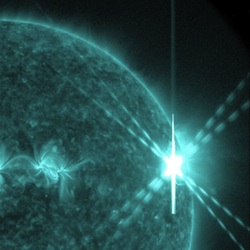 In that morning, British astronomer Richard Carrington was projecting the Sun’s image on a canvas, and drawing its sunspots on his notebook. Suddenly, a flash of light appeared over the spots, so intense, that he found it difficult to look directly at it. He left in a hurry, looking for a witness to this event, but when he returned about a minute later, the first registered solar flare in History was already fading.
In that morning, British astronomer Richard Carrington was projecting the Sun’s image on a canvas, and drawing its sunspots on his notebook. Suddenly, a flash of light appeared over the spots, so intense, that he found it difficult to look directly at it. He left in a hurry, looking for a witness to this event, but when he returned about a minute later, the first registered solar flare in History was already fading.
In a few second, a flare can release energy equal to a thousand million (that’s a billion, in the US), megatons of TNT.
I know this number is too big to mean anything, so let me try to downsize it a little: That’s 20 million times the energy of the most powerful nuclear bomb ever built!
Not much better, is it? Maybe take it down an extra notch? It’s the same energy the whole Earth receives from the Sun… in 278 days! That’s the total energy arriving from the Sun in more than 9 months! The BIG difference is that a Flare lasts a few minutes at most.
Travelling at about half the speed of light, the energy from a solar Flare can reach the Earth in as little as 15 minutes.
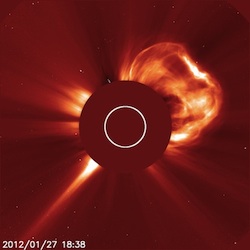 But that’s not all. Sometime associated with a Flare, there are Coronal Mass Ejections (CME’s). A CME is formed when a magnetic field closes, encasing inside a bubble of solar plasma. Free form the Sun, this bubble is then ejected from into space. Fortunately a CME travels much slower than a Flare, so if they are ejected in the Earth’s direction, they can take between 2 and 4 days to arrive.
But that’s not all. Sometime associated with a Flare, there are Coronal Mass Ejections (CME’s). A CME is formed when a magnetic field closes, encasing inside a bubble of solar plasma. Free form the Sun, this bubble is then ejected from into space. Fortunately a CME travels much slower than a Flare, so if they are ejected in the Earth’s direction, they can take between 2 and 4 days to arrive.
With its own magnetic field, when a CME impacts the Earth’s magnetosphere, it interacts with it. The solar plasma will travel along the magnetic field lines, and impact the Earth’s atmosphere in the magnetic poles. When this happens, the solar plasma ionizes the atmosphere, much like an electric current ionizes the gas trapped inside a fluorescent bulb. The atmosphere starts to glow, in shades of green and red – the Aurora (borealis, in the northern hemisphere, or australis, in the southern hemisphere).
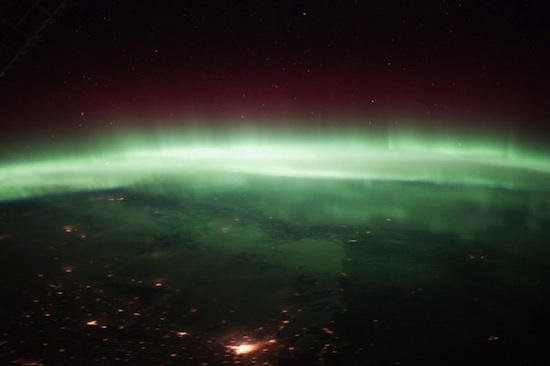
ISS-30 Aurora Borealis above Manitoba,Canada. Image: (NASA)
All this activity from the Sun, when it’s released in the direction of the Earth is generally known as Solar Storms. If they affect us directly or indirectly, these effects are known as Space Weather.
A solar flare, when it impacts the Earth, can affect the ionosphere, the layer of our atmosphere used to reflect long range radio signals. GPS and communication satellite signals also have to cross this layer to reach the surface, so a solar storm can affect communications, and even cause full blown communication blackouts.
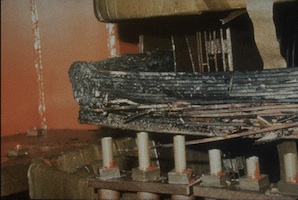 The energy of these storms is also responsible for charging satellites orbiting the Earth, which can damage their electrical components. Even electrical blackouts are possible, due to induced currents in the distribution grid. On March 13th 1989 Quebec was without electricity for 9 hours, after an induced current had blown HydroQuebec’s transformers.
The energy of these storms is also responsible for charging satellites orbiting the Earth, which can damage their electrical components. Even electrical blackouts are possible, due to induced currents in the distribution grid. On March 13th 1989 Quebec was without electricity for 9 hours, after an induced current had blown HydroQuebec’s transformers.
Solar storms also produce radiation at high altitudes. Nothing to worry about at the Earth’s surface, but at the altitude of the International Space Station, they may prove fatal to an astronaut performing an EVA. Even at airplane cruising altitudes, air traffic controllers will divert planes from polar routes, and lower their altitude. A violent solar flare can produce, at an airplane’s cruising altitude, radiation equal to 1000 chest x-rays.
Fortunately, early warning solar observatories are now in place, like SOHO, STEREO and SDO that help us prepare for some of the Sun’s explosive effects.
|
|
Ricardo Cardoso Reis is an outreach assistant at Centro de Astrofísica da Universidade do Porto (Center of astrophysics of U.Porto), in Portugal, where he produces and presents show in the Planetarium of Porto, writes news and press releases, orients telescope observing nights (and days), and supervises hands-on activities in projects as Junior University, Researchers Night in Europe or "Astronomy in the Summer". In 2007 he represented CAUP in the SWEETS consortium (Space Weather and Europe - an Educational Tool With the Sun), where he produced the original planetarium show "Thunderstorms in Space Weather" and co-produced a multi-language DVD-Rom. During the International Year of Astronomy 2009 he was the coordinator of the global project Dawn of IYA2009 and was a task group member of the Solar Physics Task Group, 100 Hours of Astronomy (100HA) and Galilean Nights (GN). He is an editor at Portal to the Universe and chair of GAM2011 Solar Programs working group. |








